-
Posts
1,602 -
Joined
-
Last visited
Content Type
Profiles
Forums
Articles
Gallery
Downloads
Events
Posts posted by Nobody Special
-
-
Does this mean, Frosty that you only celebrate Pi day on March 14 at 03:49 a.m. (i.e. 229 minutes or .15926535, etc of a 1440 minute day)?
-
Regarding ghosts, I'll apply Granny Weatherwax's advice on gods in the Discworld. I ain't saying they ain't real, I just don't you should go around encouraging them by believing in them.
-
Regarding sickles and scythes, at least traditionally they were sharpened constantly through the use of whetstones and peening the blade's edge way thinner than feels comfortable on a small stake anvil. It's a righteous pain to do until you get used to it, but in the right hands (i.e. not mine) they cut insanely fast. This has changed somewhat in America, where the tradition is to have a thicker spine and sometimes the beveled part of the blade.
The videos of cutting grass with a European style scythe are hypnotic and almost feel fake, especially if you're watching one where someone almost keeps up with a modern farm machine.
-
As I'm given to understand, rampage first, booze, then a little more rampage before "Mongo just pawn in great game of life" and going Goodnight Irene. Slept it off and was good to go after. Since we're in a curio section and on weird history, elephants have an absolutely insane history in America.
They were frequently shot in parades after being advertised as having skin that was bulletproof, and in at least one instance, one was hanged after killing a freshly recruited hobo handler that beat her too much. They hung it from a gantry hook on a railroad car, the chain used for the travesty broke and it displaced a hip, then they did it again, buried it, and dug it up again and staged a photo of the event for the papers the next day. You can find it easily using the googles.
Then there was the one that was sentenced to death and electrocuted on the bridge to Coney Island...they made copper shoes for it just to ensure that it would get sufficient grounding.
There was a great microhistory on the whole subject called Elephants in America.
-
I don't have a lot to add to the Bigfoot arguments, living in the middle of the supposed territory, but I saw a sundog once, and there's a town near me that had an elephant go on a drunken rampage, Tusko, in Sedro-Wolley. Handler got it off a circus and would tour it up and down the coast, come and see it for two bits. Settled in for the winter and took it out for a walk when it decided to go walkabout. Knocked at least one house of its foundations, smashed a few cars, and drank an entire Prohibition-era tank of sour mash.
No I told you all that because shiny-keys, squirrel, gestalt!!! and I came in to point out that Doc Nichols of the whiteboard fame used to hang out on here and I believe still has old posts if you can find them.
-
To touch on that earlier bit, working marble glass at high temps makes it sag, or slump, so if you're looking to keep the shape, as above, do the last bit cold. If worked hot, and you slump glass into a circle, slit, or bezel it looks cool as heck, but with iron it tends to crack as it cools because of the different coefficients of friction, i.e. the iron and the glass contract different amounts or at different rates. Plus if not annealed, the glass often cracks anyway from thermal shock.
This makes for a really cool crazed sort of eye of Sauron effect if you want, but too much and you're risking glass splinters or it falling out of the piece. Copper on the other hand, or even bronze usually works well with it because they have very close coefficients of expansion to glass. Stan, aka trying-it used to play with copper and glass a lot, and he got me toying with it a few years ago before he passed.
Different glasses also have different temps, so some glasses have to be hotter than others. Also, also, just in case I haven't babbled enough, you can slump and even melt at least some glass in a microwave...if you start it with a torch first. NOT OSHA recommended though (i.e. it ain't remotely safe) and can be pretty rough on the microwave.
And for the truly insane...under the power hammer.
-
On 2/26/2024 at 12:14 PM, Scott NC said:
I was all sold/traded off at once. Pliny wrote about it. 900 camel loads, but then who knows for sure. People came to see the ruins.
As I recall, Pliny was about 600 years early for the Ummayid invasion of the island of Rhodes, although he did write about the ruins. A camel can typically carry maybe 600 lbs, so times 900 camels that makes for about 540,000 lbs of marble and bronze if true.
So, if it was made out of bronze or brass plates with an iron framework and was roughly the size of the Statue of Liberty, which weighs 450,000 lbs..the size would be about right, especially if they took some of the marble base. Still a crazy logistics problem though to get it back to the mainland, arrange food and water for 900 camels on a 1000 mile trip across the Taurus mountains all the way back to Aleppo.
-
Definitely cast iron, maybe had a steel plate at one point. So, best guess is a Vulcan or Southern Crescent, although that doesn't look like a Southern Crescent's feet. I'd bet on Vulcan, but with that plate on the side you can't even look for the logo. Poor thing has been rode hard and put up wet either way. I'd consider giving that one a warm and quiet place to nap.
-
I love cast iron, but have you tried cooking with carbon steel? Lighter, more even heat, and you can transition between different levels of heat much faster. And I even hear that it's something a blacksmith could make...
I'm always torn when I melt down pewter or cut up metal objects. I can get pewter, silver, and sometimes bronze, brass, or copper from cookware, plates, etc. at the thrift store for next to nothing, but I always feel guilty when I'm cutting it up and destroying something already finished. On the other hand, when you start to look at what it would cost to buy...
I love the look of pewter inlays, caps, and bolsters, and it's not like tin is getting any cheaper.
-
On 2/24/2024 at 6:55 PM, Will Brouwers said:
Thanks for educating me on the use of mouse holes Frosty! Any chance you remember where you learned that information?
It's fairly common knowledge and is mentioned in a few of the more available books and online. Couldn't tell you if it made it's way into Anvils in America; I can't afford it. I've also seen it done a couple of times in manipulating anvils to work or heat treat by one of the formerly major German anvil makers.
-
Trying to figure out which of the Old World/New World connections are legit and which are bogus will drive you nuts. I want to believe a lot of them, like some of the medieval mystery men appearances in Europe thought to be Native Americans, or the theory of Basque cod fisherman hitting the Grand Banks in America well before Columbus got to town.
We know that there was a lot more traffic than you learned with "In 1492, Columbus sailed the oceans blue". But which ones? The evidence is hard to find and to prove and speculation is rampant. Things like the fake Viking runestones don't help either. How cool would it be though, if this one was true? My family thought I was nuts when we went to a science museum in N. Georgia and I spent way too long looking at a small boulder size piece of float copper that had made its way down there.
-
So, I haven't been locked away in a Turkish prison, just got busy with work. A quick update: I've been trying to learn and relearn things as fast as I can go. Closed green sand castings are more complicated than the farting around largely with open faced molds that I did when dinosaurs roamed the earth.
Reading foundry sources online, green sand casting books from antiquity, and the old standby - the 1958 Navy foundry manual. I bought 2.5 front end transmissions for about 20 bucks each and broke them apart. Frosty suggested a splitting maul, which I have to admit is a little rough on the maul but does wonderful things to the transmission. Gonna be about 60-70 lbs of aluminum plus some random rods, ball bearings, and bearing races to play with later.
Made some new, fine grade green sand which works about a hundred times better than the medium grade - may still save the courser stuff as backing sand for projects down the road. You can see the difference in the ingots below.
I've got about 16 lbs of clean metal now and intend to start the bed pattern this weekend. Reading machinist forums online - a lot of them say this design has simplicity going for it but that the lathe has issues with chatter, partially due to the thin bed tending to twist. They suggest several improvements for the bed, which is one of the first and most difficult castings. 1. Use wider and thicker ways, i.e. the steel rail that sits on top of the bed. This means making the bed wider. 2. Thicken the bed and use countersunk screws down the length of it rather than four large bolts through ellipsis shaped holes. 3. Use x-shaped braces instead of straight braces. 4. Don't feed directly onto the middle of the pattern to avoid turbulence. Instead of a "pop gate", use a regular sprue, runner, and feeders, bottom feeding the mold at the parting line.
I've gotta say, this makes sense, but I'm dumb enough to want the "full Gingery experience", so I may make one of each. This means almost double the metal needed for the mold though. I'm attaching notes showing the general difference in the amount of metal needed, and kind of roughing out the two designs.
Things learned or relearned the last two weeks: Don't use sand that's too wet. Or too dry, dummy. Fine sand good, not-fine bad. Runners and gates are easier if you use a pattern. That pattern should be round in cross-section. But not a full round or you can't get it back out without collapsing the mold. Oops. Also don't leave the patterns where your pit bull can get at them. Swab carefully. Double check your alignment pins so you know the flask closed fully. Remember to flux. Clean the crucible immediately after use. Top feeding large ingot patterns causes turbulence and blowholes from trapped air when the sides chill the metal, even when the top and bottom look great (see two sideways ingots). Don't forget the vents!
-
I've used perlite in homemade refractories - it's not absolutely terrible in a solid refractory such as a casting furnace wall, such as a sand clay mix or the old backyard metalcasting mix with portland cement (do not recommend, it slags out over time) but it wasn't great either. I wouldn't want to mess with it in this kind of application - too melty at high temps.
I know it was just a slip of the tongue, but do be careful about substituting vermiculate for perlite in any application. Perlite merely aerates soil, but vermiculite also is hydroscopic - it absorbs water from the soil and air. When heated that can be a disaster, especially in homemade refractories. Not overly crazy about homemade refractory mixes anyways; I get the urge to try them, and have, but they never quite work as well as the real stuff.
Best of luck
-
I mean...maybe? I don't have any room to criticize after a few of my contraptions. Now if they can do the reverse, color me amazingly impressed.
-
If not exposed to moisture, my experience has been pretty well, depending on how it was applied. I had some accidentally electroplated harmonicas on which it lasted about a year under heavy use and being put in my mouth a lot. I've still got some stuff I made forging copper plated grounding rod in 2008 and most of it has held up. If exposed to moisture it goes considerably faster. Kinda like sweet iron bits for horses. They start off coppery so the horse takes the bit better, then the copper wears off over time, with the idea the horse gets used to it.
-
You would want to check with someone that owns the book Anvils in America, but I believe that puts it at approximately 1937.
与拥有这本书的人核实 Anvils in America。应该是1937年左右 -
Supposedly Wild Bill Hickock was buried with an 1870-ish Springfield with a pewter cap, they dug it up when they moved the grave. It was heavily customized though.
You can see it here:
-
English anvils, early ones were forged with a steel plate, later ones were cast steel - reputed to be good but prone to edge chipping if you don't radius the edge. Seen a few, never used one.
-
My wife is allergic to metals too, nickel gets her, including high nickel steels, and any copper, so bronze, brass, even gold under 20k can break her out. She can hit a doorknob that has the protective coating worn off and she'll end up with hives. Copper pans for whipping egg whites is a huge no-no. I was fixing the neighbor's broken pipes today and she was watching me. Kept saying, "Can't touch that, can't touch that..."
She also gets bad cracks and dermatitis in the winter, treats with steroids and lotions, the dermatologist recommended staying away from hot water for one, and she was getting strong UV light treatments which helped a lot. Gold bond eczema creme and prescription halobatisol.
-
Minor setback today. My dog ate two molding boards, a pattern, and the parting powder! Bloody pit bulls.
-
Can see writing, but a bit much for me to make out. Usually oblique lighting is your friend for this. A bit of a rorschach test and guesswork at this point. There's clearly an A, and maybe an HOL above it. That makes me want to guess Mousehole but I doubt it, especially without the dots between the numbers. Dunno, maybe someone more experienced than me can see it. I would try the other side too, they often have stamps on both sides.
-
Be glad it was rain. There's nothing like finding out the hard way that you should have kept your coal covered better and a cat has been peeing in it.
-
It doesn't really tell you who made the anvil, and if there is an A, I would tend to think it most likely an inspector's mark., although Lord knows I could be mistaken. It does eliminate most of the ones that had depressions in the bottom. Unfortunately, that still leaves a few hundred makers or so. Did you have any luck tilting it and rubbing baby powder or something similar into the sides to bring faint depressions into relief? I've had some that the marks were completely unreadable on until I did that. Even then they were often faint.
I liked the show. There was a lot of silliness, drama, and contrivance, but it was fun to watch and heck, every once in awhile I saw someone I knew.
-
I'm sorry to hear about your wrist. Guessing not enough grip strength in it to try and learn to hammer with the other hand. Nerve damage is incredibly hard to come back from. That's a lovely chisel, regardless.
My shop day wasn't nearly so productive. Rainy, windy day so I mixed some new green sand, a lot finer than what I've been using. 200 lbs of 70 or 80 mesh sand, I forget, 20 lbs of bentonite, 2.2 lbs of regular white flour, and about 10 lbs of water. Mixed it up and mulled it a little bit, now gotta let it sit for a day or two before I can mull it properly.
It's barely into the fine sand range but compared to what I was using it felt like powdered sugar. For that matter, the way it wants to bunch when you first add water reminded me a lot of mixing cold butter into flour when making biscuits.

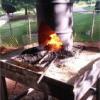
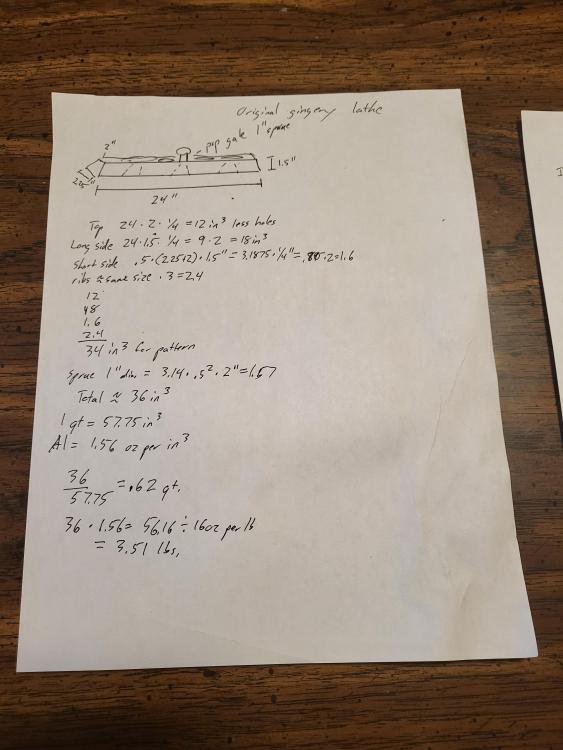
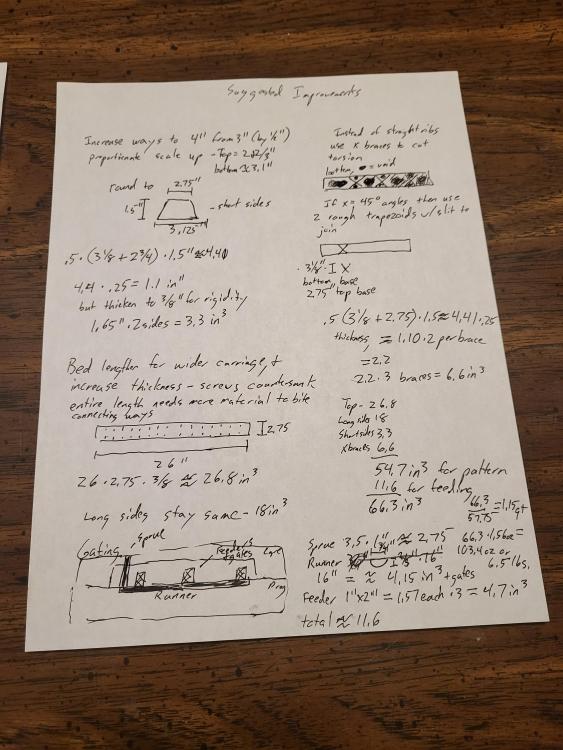
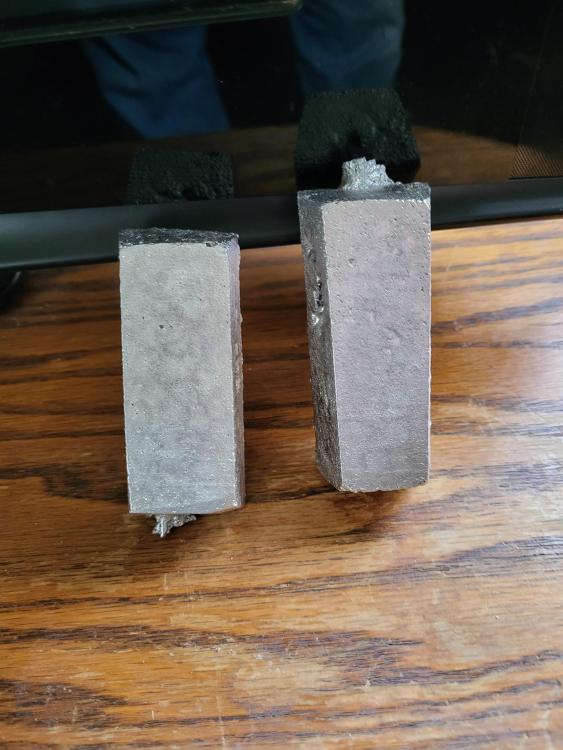
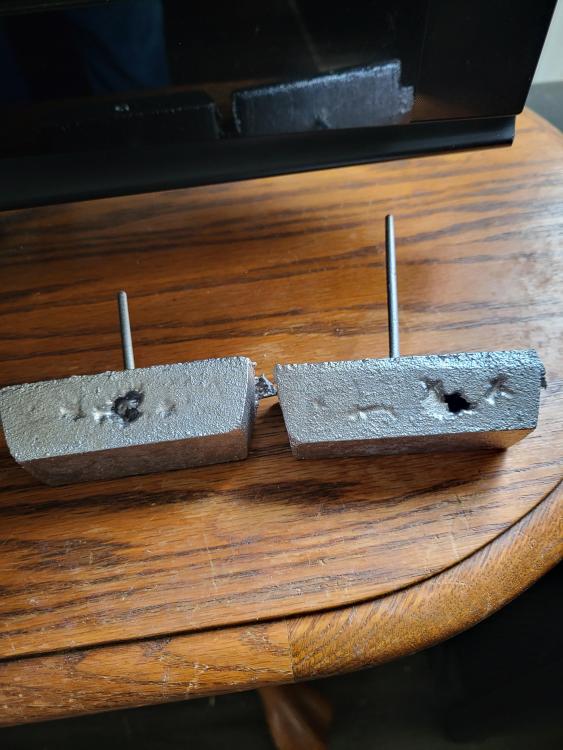
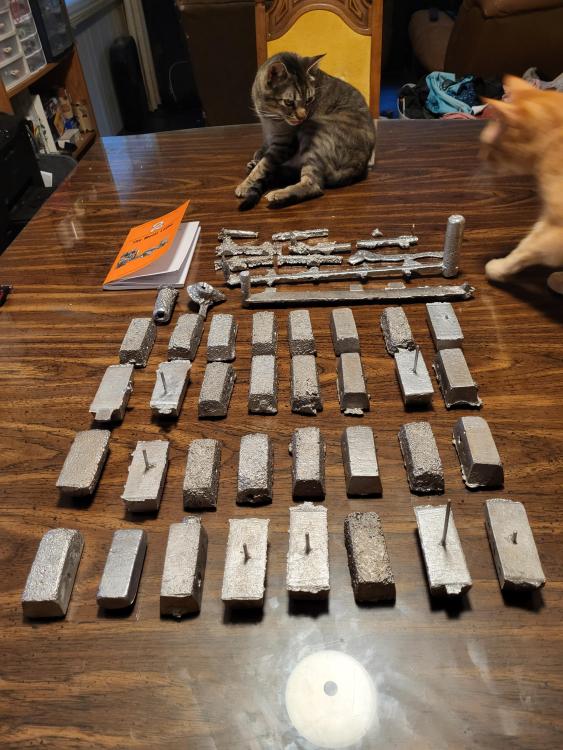
More Hacks (Tips). Worth a look.
in Shop Tips n' Tricks
Posted
This also depends on what you call a bug, and for that matter what you call a lung. If you include arachnids, then you get book lungs, at least for some of them. Book lungs don't work like people lungs though, they're basically a bunch of folds that increase the amount of surface area the arachnid can absorb oxygen through without having to be moved. Kind of like an air-cooled Volkswagen, surface area matters. They probably evolved from specialized gills, although some of the smaller arachnids, like mites, breathe in pretty much the same fashion as insects.
And while I'm thinking about it, keeping spiders in your trash would probably cut down on the fruit flies, but I'm not sure that it's practical, although it would be fun to refer to the kitchen trash can as Cirith Ungol.